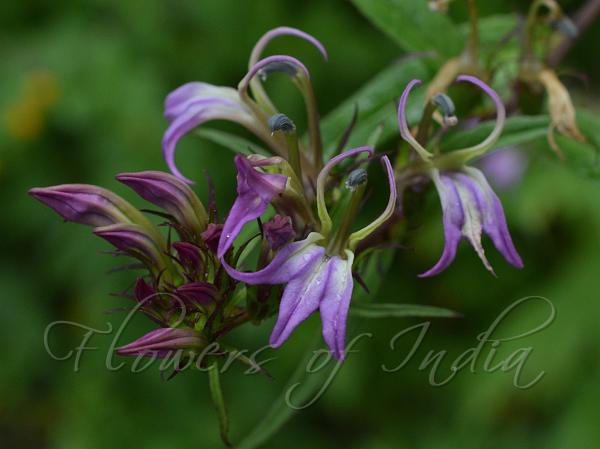|
| Pyramid Lobelia |
|

|

| File size | 757746 |
| Original date | 10/2/21 3:58 PM |
| Resolution | 5699 x 3551 |
| Flash | Flash did not fire |
| Focal length | 40.0mm |
| Exposure time | 1/160s |
| Aperture | 13.0 |
| Focus Distance | |
| Metering Mode | Multi-segment |
| Camera make | NIKON CORPORATION |
| Camera model | NIKON D5300 |
| Sensor type | OneChipColorArea |
|
|
|
|
Photo: |
Botanical name: Lobelia pyramidalis Family: Campanulaceae (Bell flower family)
Synonyms: Rapuntium pyramidale, Lobelia wallichiana, Dortmanna pyramidalis
Synonyms: Rapuntium pyramidale, Lobelia wallichiana, Dortmanna pyramidalis
Pyramid Lobelia is a shrubby herb, 0.4-3 m tall, with
hairless stem. Leaves are alternate, somewhat leathery, stalkless or
shortly stalked; basal leaves spoon-shaped; lower ones oblong, up to 25
cm; middle and upper ones narrowly elliptic or narrowly oblong, 12-31 x
1-4 cm, both surfaces hairless, base narrowed, margin minutely toothed,
tip tapering. Flowers are borne in paniculate racemes at branch-ends,
with flowers dense, oriented toward one side. Flower-stalks are 0.6-2.4
cm, bracts linear, often shorter than flowers, entire. Hypanthium is
bell-shaped or broadly ellipsoid, sepals subulate or linear-triangular,
8-16 x 1-1.8 mm, margin entire. Flowers are white, rose, or bluish,
1.1-2.1 cm, outside hairless, inside tube densely hairy, nearly
2-lipped; lobes of upper lip linear, about 2/3 as long as total length
of flower; those of lower lip elliptic or lanceshaped, about 1/3 as
long as total length of flower. Stamens are fused into tube above base;
anther tube about 5 mm. Capsules are nearly spherical, oblate, or
broadly ovoid, 3.5-6.5 mm in diameter, hairless, often drooping.
Pyramid Lobelia is found in the Himalayas, from Kumaun to NE India, N.
Burma, Indo-China, at altitudes of 1100-2300 m. Flowering:
January-May.
| Identification credit: D S Rawat | Photographed in Madhmaheshwar Valley, Uttarakhand. |
• Is this flower misidentified? If yes,